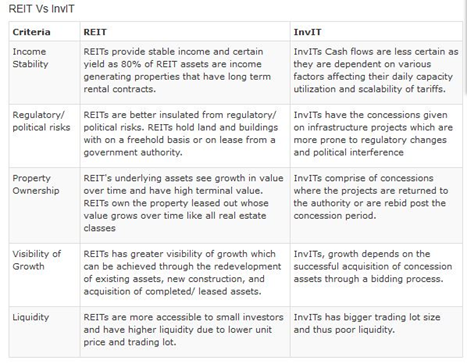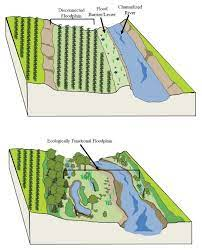todays current affairs 30th august 2023

REITs and InvITs
GS Paper III (Economy)
Context: In order to increase the appeal of real estate investment trusts (REITs) and infrastructure investment trusts (InvITs) to investors, the Securities and Exchange Board of India (SEBI) has approved significant revisions to the rules regulating these entities.

What are REITs and InvITs?
|
Real Estate Investment Trusts (REITs) |
Infrastructure Investment Trusts (InvITs) |
|
|
Structure |
Investment trusts owning real estate properties |
Investment trusts owning revenue-generating infrastructure projects |
|
Regulation |
Regulated by SEBI |
Regulated by SEBI |
|
Assets |
Commercial real estate properties (no residential) |
Operational infrastructure projects |
|
Units |
Units issued to investors, traded on stock exchanges |
Units issued to investors, traded on stock exchanges |
|
Distribution |
Mandatory distribution of a significant portion of income as dividends |
Mandatory distribution of a certain percentage of cash flows as dividends |
|
Tax Benefits (Dividends) |
Dividend distribution exempt from DDT |
Dividend distribution exempt from DDT |
|
Taxation (Investor’s Dividends) |
Taxable as per investor’s income tax slab |
Taxable as per investor’s income tax slab |
|
Asset Focus |
Commercial properties: office buildings, malls, etc. |
Operational infrastructure projects |
|
Purpose |
Income generation and capital appreciation |
Income generation and capital appreciation |
|
Project Type |
Income-generating properties |
Operational brownfield projects |
|
Examples in India |
Embassy Office Parks REIT, Mindspace Business Parks REIT |
IndiGrid Trust, IRB InvIT Fund, Sterlite Power Grid Ventures InvIT |
Importance of REITs and InvITs:
Sponsors may engage in real estate or infrastructure projects through the use of REITs and InvITs, which function as investment pooling vehicles.
Retail investors now have access to income-producing real estate investments that they couldn't otherwise buy thanks to REITs.
Individual and institutional investors may make direct investments in infrastructure projects throughout the transportation, energy, and communication sectors thanks to invITs.
Performance of REITs and InvITs:
REITs have gained popularity since their inception in 2019 and have proven to be resilient in the face of adversity like the pandemic.
IRB InvIT Fund and Embassy Office Parks Reit are only a couple of the many listings available for invITs, which have a wider reach.
REITs and InvITs registered with Sebi handled assets surpassing 3.5 trillion at the start of 2023.
Sebi’s Amendments Explained:
Unit holders of InvITs and REITs now have the ability to nominate directors, giving them more clout.
With the amended minimum unit holding requirement, sponsors now have more options.
The idea of self-sponsored investment managers was established by Sebi, allowing them to take over the duties of Reit sponsor.
Importance of the Changes:
These changes aim to improve corporate governance and simplify how InvITs and REITs operate.
By giving them a voice and enforcing responsibility through the Stewardship Code, the amendments provide retail unit owners more leverage.
The minimum number of units must now be maintained by sponsors for the duration of the Reit or InvIT.
This idea gives Reit sponsors freedom and possible departure strategies.
Source: The Hindu
Preventive Detention
GS Paper II (Polity & Governance)
Context: In Haryana, a few persons were placed in preventative custody (preventive detention) ahead of a religious parade.

What is Preventive Detention?
An someone is taken into custody after being accused of a crime.
Without charging someone with a specific crime, preventive detention includes holding people to stop them from taking acts that might undermine law and order.
Preventive Detention in Indian Law:
If they believe someone is engaging in illegal activity, police officers have the right to make an arrest without a warrant or an authorization from a judge.
If a person's freedom endangers national security, international relations, the welfare of the nation, or the public interest, this legislation allows for their arrest and imprisonment.
UAPA gives the state the authority to jail those who contest Indian territorial sovereignty or are members of organisations that have been deemed unlawful.
Constitutional Safeguards and Exceptions:
Articles 22(1) and 22(2) of the constitution provide that those who have been arrested are told of the charges against them, have a right to legal counsel, and are brought before a magistrate within a 24-hour period.
However, these protections do not apply to anyone detained for preventative detention under specified legislation or hostile aliens.
Preventive Detention Statistics:
According to the NCRB study, there has been an increase in preventative detentions, with over 24,500 people being held by the end of 2021, the most since 2017.
Over 483 of these detentions were made in accordance with the National Security Act, and by the end of 2021, over half were still being held.
A total of 67,084 persons were arrested as a preventative measure in 2017, of which 48,815 were released after six months and 18,269 were kept in jail.
Concerns and Legal Perspectives:
Since 2017, there have been more preventative detentions, with a big jump in 2021.
Preventive detention should only be used to stop public disturbances, the Supreme Court has emphasised, and it should not be used in place of regular legislation to uphold law and order.
Preventive detention helps to suppress antisocial and subversive elements, but also raises questions about possible misuse, arbitrary decision-making, and infringement of civil rights.
Source: The Hindu
Flood Plains
GS Paper I (Geography)
Context: For more than a month, Punjab has been dealing with severe flooding that has mostly affected the communities around rivers like the Sutlej, Beas, Ravi, and Ghaggar. These regions, which are well-known for having rich flood plains, have been worst damaged because of floods that have been made worse by encroachment and building.

Flood Plains and their Significance:
River flood plains act as a natural barrier against inland floods. They absorb excess water and protect other areas when kept free of concrete intrusions.
Flood plains that are well-managed also help to recharge groundwater levels and sustain the water table.
What is Zoning of Flood Plains?
The practise of classifying and controlling various locations within flood-prone regions according to their susceptibility to flooding and the severity of flood occurrences is known as "zoning of flood plains."
This attempts to regulate land use and development activities in these regions to reduce the risks of flooding, safeguard infrastructure and communities, and maintain the flood plains' natural functions.
It entails identifying certain zones within flood-prone areas and creating rules and restrictions for building, development, and land use in each zone.
Current Scenario: No Zoning in Punjab
According to NGT regulations, building should not take place 500 metres or less from a river's centre lining.
Punjab has neglected to begin the process of floodplain zoning despite the instructions from the NGT and its necessity. Continual encroachments put riverbank settlements in danger.
Impact of Inaction: People and Ecosystems Affected
Uncontrolled development raises the risk of flooding farther inland, worsening the effects of floods.
Flood plain concreteization reduces soil fertility and quality while delaying water drainage.
Flood Prone Districts and National Issue:
The need for readiness is heightened by the fact that several districts, including Ropar, Ludhiana, Ferozepur, Patiala, and others, are located on flood plains.
Although just four states have implemented flood plain zoning in practise, this is not enough. Even areas that have implemented zoning have failed to clearly define and demarcate flood basins.
Activists’ Advocacy:
In Punjab, environmentalists and NGOs have pushed for flood plain zoning as a risk-reduction measure.
Flood plain zoning must be started right away and finished in order to protect people, property, and ecosystems from damaging floods.
Conclusion:
The most recent floods in Punjab highlight how crucial flood plain zoning is to prevent disaster.
The state can protect its residents and environment from the negative effects of unrestrained building and floods by implementing appropriate zoning rules.
Punjab must move quickly to implement flood plain zoning and safeguard its susceptible areas from the ongoing danger of flooding.
Source: The Hindu
Nabhmitra
GS Paper III (Science & Technology)
Context: 'Nabhmitra,' a ground-breaking invention created by the ISRO Space Applications Centre (Ahmedabad), is intended to increase the safety of fishermen when they are engaged in marine operations.

About Nabhmitra:
While at sea, Nabhmitra uses satellite-based connectivity to provide smooth messaging services.
The local language will be used to communicate weather alerts, cyclone warnings, and other crucial information.
In the event of an emergency, such as a capsize or a fire, fishermen can broadcast distress signals.
The gadget has an emergency button that allows for immediate contact with the control room.
The control centre gets the warning and the boat's position when the emergency button is pressed. The control centre simultaneously sends a response message to the boat's crew.
Benefits of Nabhmitra:
Nabhmitra improves fishermen's safety by facilitating quick communication in times of need.
Fishermen are provided with timely weather and cyclone information, which helps them make wise judgements.
Information about fishing grounds, marine boundaries, and shipping lanes is provided by the gadget.
The tool facilitates communication between boats and authorities during emergencies or accidents.
Source: Indian Express
ISRO’s Upcoming Missions
GS Paper III (Science & Technology)
Context: An important milestone in space exploration was reached with the successful landing of the Chandrayaan-3 lander by ISRO in the South Polar Region of the moon. The spotlight now changes to India's multifarious operations, prospective missions, and technical developments as it becomes a major participant in the sector.

Diverse ISRO Activities:
The ISRO's operations include a wide range of space-related demands, including research, satellite development, rocket manufacture, infrastructure maintenance, and more.
The "Gaganyaan" human spaceflight project, the Reusable Launch Vehicle Technology Demonstrator (RLV-TD), the development of the SCE-200 engine, and the Small Satellite Launch Vehicle (SSLV) are some of the prominent areas of concentration.
Glimpses of Upcoming Missions:
Aditya L1: Due to launch in September 2023, Aditya L1 will conduct a thorough investigation of the sun in order to shed light on its many processes.
NISAR spacecraft: Launched in January 2024, the joint ISRO-NASA NISAR spacecraft will use cutting-edge radar technology to examine earth's surface processes.
Gaganyaan G1 and G2 Flights: In 2024, human-rated rocket test flights take place as a lead-up to India's ambitious Gaganyaan human spaceflight programme.
Beyond Launches: Technology Innovations
The RLV-TD's architecture, which is similar to the NASA Space Shuttle, allows for air propulsion or gliding and can carry 20,000 kg to low-Earth orbit.
In order to improve efficiency and safety, ISRO investigates cutting-edge rocket fuels including methalox propellant and electric propulsion systems.
Moon Missions and Lunar Exploration:
Chandrayaan-3 and Beyond: Chandrayaan-3 opens the door for more lunar exploration, including the LUPEX (Lunar Polar Exploration) mission that will be carried out in cooperation with JAXA.
LUPEX's Objectives: In order to research the South Polar Region of the moon, including subsurface sample extraction and night survival, LUPEX plans to send out an advanced lander and rover.
Expanding Collaborations and Global Partnerships:
By launching OneWeb satellites and, as was predicted, the PROBA-3 satellites of the European Space Agency, ISRO fills in the gaps created by the sanctions on Russia.
Working with JAXA on LUPEX demonstrates ISRO's dedication to international collaboration in space exploration.
Mars and Venus Missions:
Building on the success of its previous Mars Orbiter Mission (Mangalyaan), ISRO intends to visit Mars once more.
The 'Shukrayaan' mission's ambitious aims to investigate Venus show how far ISRO is willing to go planetary research.
Conclusion:
ISRO's outstanding achievements and upcoming endeavours highlight its position as a major player in the global space race.
ISRO continues to influence the field of space exploration through its lunar landings, solar research, human spaceflight, and interplanetary missions.
By breaking down barriers, promoting innovation, and fostering global cooperation, ISRO solidifies its position in humanity's quest to understand the workings of the universe.
Source: Indian Express
Facts for Prelims
Tele-Law 2.0:
Tele-Law-2.0 was introduced by the Ministry of Law and Justice and combines Tele-Law with the Nyaya Bandhu App to guarantee access to justice.
Through the Tele-Law Citizens Mobile Application and teleconferencing services offered at Common Service Centres, Tele-Law aims to link the beneficiary and the lawyer.
Nyaya Bandhu (Pro Bono Legal talents) unites qualified disadvantaged beneficiaries with practising attorneys who are interested in giving their time and talents as volunteers.
At the district level, lawyers from NALSA are onboarded to offer Tele-Law Services and Pro Bono Legal Services.
Fleet Support Ships (FSS):
The purchase of five FSS for the Indian Navy was authorised under a deal between the Ministry of Defence and Hindustan Shipyard Limited.
The first of its type FSS of 44,000 tonnes will be constructed in India by an Indian shipyard.
FSS will be used to supply gasoline, water, ammunition, and supplies to ships at sea.
deployed for Human Assistance and Disaster Relief (HADR) missions and the evacuation of people.
Significant benefits include increased strategic reach and fleet mobility, improved Indian Navy blue sea capability, job creation, and progress towards self-sufficiency in the military industry.
Nataraja Bronze Sculpture:

The Nataraja Bronze sculpture dates back to the Middle Ages and was created in South India during the Chola Dynasty's reign in the 12th century CE.
A prabhamandala, or circle of fire, encircles Lord Shiva.
The damaru, a hand drum used to create the first notes, is held in the upper right hand.
The fire that will end the cosmos, agni, is held in the upper left hand.
Right lower hand does the abhayamudra (fear-soothing gesture).
The dwarf-like figure being crushed by his right foot symbolises apasmara purusha, or the delusion that causes humans to err.
Left hand in front, pointing to his lifted left foot, represents a haven for a troubled spirit.